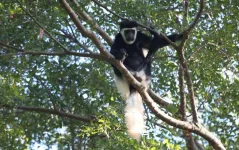(Press-News.org) In a growing and changing world, we need to find ways of putting food on everyone’s table. Pesticides have enabled mass cultivation on an incredible scale, but they can have harmful secondary effects on humans and wildlife, and pests are rapidly evolving to overcome them. To overcome this challenge and develop the sustainable and resilient agriculture of the future, scientists writing in Frontiers in Science explore the potential of induced resistance. Like a vaccination for plants, it deliberately triggers a plant’s immune system, so that when the plant encounters a similar stress in the future, it fights back better.
“While induced resistance has been studied for decades, its exploitation in crop protection has only recently begun to gain momentum,” said Prof Brigitte Mauch-Mani of the University of Neuchâtel, lead author of the article. “We argue in favor of a holistic approach to crop protection, which combines multiple strategies to deliver tailored solutions. Induced resistance sits in the heart of such an integrated approach.”
Food for thought
Right now, crops are mostly protected using pesticides and breeding for resistance genes, although there is a significant risk that pests will out-evolve plants intended to resist them. Induced resistance enhances abilities a plant already has to provide more sustainable and potentially broader-spectrum protection: defending against several pathogens and pests, not just one.
Induced resistance can take several different forms—for instance, plants releasing compounds which attract herbivores’ predators—but the best known and most widespread is defense priming. Defense priming takes place when part of a plant experiences a stress, and this weakly activates defense mechanisms which then activate fully when the plant undergoes another attack. Intriguingly, this priming seems to last so long that it can appear in the next generation of plants, potentially transmitted via epigenetic mechanisms.
However, induced resistance usually doesn’t offer complete protection, so must be combined with other measures. It also needs to be carefully calibrated to ensure that it doesn’t leave a plant open to other threats and doesn’t compromise growth by causing the plant to allocate too many resources to defense.
“Induced resistance is the result of a complex network of developmental and environmental pathways in the plant,” explained Mauch-Mani. “So safe and efficient exploitation of induced resistance is not as straightforward as the introgression of a single gene or spraying a single pesticide. We will need case-by-case evaluation of the optimal growth conditions, crop germplasm, and agricultural practices to capitalize on induced resistance’s multifaceted benefits.”
Seeds of the future
Once implemented, induced resistance could do more than just ward off pests. Some of the defense compounds that plants produce in response to induced resistance are linked to health benefits or higher-quality nutrition, meaning that we could benefit not just from avoiding pesticides but from eating healthier food. Induced resistance is also faster than traditional breeding, offering a quicker way to adapt to changing climatic conditions. It’s harder for evolving pests to evade, and it has the potential to offer broad-spectrum protection.
Combined with integrated pest management that uses pests’ natural enemies as crop protection, we could use induced resistance to cut pesticides to a bare minimum, making agriculture more sustainable. We could also secure much longer-lasting crop protection, once we develop a better understanding of the epigenetic mechanisms that transmit defense priming to a new generation.
To make induced resistance part of farmers’ and food scientists’ toolkits, the researchers said we urgently need more research that covers more real-world circumstances. We also need to understand how induced resistance performs under less controlled conditions and support the development of methods that can be scaled up to field trials and then into full-scale agriculture. The researchers also called for legislative support to establish quality standards, protecting producers and consumers.
“We strongly believe that fundamental research into induced resistance will be critical for the transition towards a truly sustainable food supply,” said Mauch-Mani. “However, there is an urgent need for better communication between discovery-focused research and other stakeholders who have the expertise to translate discovery into application.
“Governments need to create a research environment and funding climate that allows for more efficient knowledge exchange between scientists, policymakers, and industry. Like the biology underpinning it, successful exploitation of induced resistance relies on a multifaceted effort.”
END
How ‘vaccinating’ plants could reduce pesticide use and secure global food supplies
Induced resistance, where plants’ immune systems are activated in a controlled way that prepares them to fight pests and disease, could help build a sustainable and resilient agricultural system
2024-10-15
ELSE PRESS RELEASES FROM THIS DATE:
Seven new frog species discovered in Madagascar: sounds like something from Star Trek
2024-10-15
Seven New Frog Species Discovered in Madagascar: Sounds Like Something from Star Trek
An international team of researchers have discovered seven new species of tree frogs that make otherworldly calls in the rainforests of Madagascar. Their strange, high-pitched whistling calls sound more like sound effects from the sci-fi series Star Trek. As a result, the researchers have named the new species after seven of the series' most iconic
If you think all frogs croak, you’d be wrong. Seven newly discovered species from the tree frog genus Boophis, found across the rainforests of Madagascar, emit special bird-like whistling ...
New temperatures in two thirds of key tropical forest
2024-10-15
Two thirds of Key Biodiversity Areas (KBAs) in tropical forests are experiencing new temperature conditions as our climate changes, research shows.
KBAs identify the most important places on Earth for species and their habitats.
The new study – by Exeter, Manchester Metropolitan and Cambridge universities – assessed 30 years of temperature conditions below the forest canopy in KBAs in tropical forests worldwide.
It found that 66% of KBAs in tropical forests have recently transitioned to new “temperature regimes” (more than 40% of temperature measurements being outside the range previously recorded ...
Fearful memories of others seen in mouse brain
2024-10-15
NEW YORK, NY — How do we distinguish threat from safety? It’s a question important not just in our daily lives, but for human disorders linked with fear of others, such as social anxiety or post-traumatic stress disorder (PTSD). The microscope image accompanying this press release, from the laboratory of Steven A. Siegelbaum, PhD, at Columbia’s Zuckerman Institute, displays a powerful technique scientists used to help us find an answer.
The scientists were investigating the hippocampus, a brain area that plays a key role in memory in humans and mice. Specifically, they focused on the CA2 region, which is ...
Rangers lead ground-breaking effort to monitor Uganda's lion population in critical stronghold
2024-10-15
In a new study published in Nature Communications Biology, wildlife rangers from the Uganda Wildlife Authority have demonstrated their ability to generate precise and reliable data on lion populations in Uganda’s Nile Delta, a critical stronghold for African lions.
The study reveals that wildlife rangers, a critical component of global conservation efforts but often underutilised in scientific research, can play a pivotal role in the conservation science surrounding the world’s most beloved big cat.
Rangers are effective at monitoring lions and are an underutilised resource
The study showed rangers ...
Modern mass extinction in an Ecuadorean cloud forest found to be a mirage
2024-10-15
One of the most notorious mass extinction events in modern times occurred on a hilltop in coastal Ecuador in the 1980s. Ninety species of plants known from nowhere else on Earth—many of them new to science and not yet given a name—went extinct when the last cloud forests of the Centinela range were cleared for agriculture. The cautionary tale of Centinela has long been a driving force in the fight to save the world’s rainforests. But did it really happen?
In a new study published in Nature Plants, an international team of botanists reveals that, indeed, it did not happen. The researchers – who spent years of scouring natural history museums, biodiversity databases, ...
HLA-DRB1*01:03 and severe ulcerative colitis
2024-10-15
About The Study: Among individuals with ulcerative colitis, the allele HLA-DRB1*01:03 was associated with severe ulcerative colitis requiring major operation, hospitalization, and systemic corticosteroid use compared with less severe disease. HLA-DRB1*01:03 has previously been linked to ulcerative colitis incidence. This study supports earlier, targeted genetic studies comparing patients with healthy controls reporting an association with total disease and severe disease requiring colectomy.
Corresponding Author: To contact the corresponding author, Marie Vibeke Vestergaard, MSc, email marievv@dcm.aau.dk.
To access the embargoed study: Visit our ...
Quantum leap in suicide prevention: Professor Philippe Courtet's visionary approach unveiled in Genomic Press Interview
2024-10-15
Montpellier, France – 15 October 2024. In a captivating Genomic Press Interview published on October 15, 2024, in the peer-reviewed journal Genomic Psychiatry (Genomic Press), Professor Philippe Courtet shares groundbreaking perspectives on suicide prevention and mental health care. As an influential PU-PH (Professeur des Universités-Praticien Hospitalier), he is a Professor of Psychiatry at the University of Montpellier, France, and head of emergency psychiatry at the University Hospital of, Professor Courtet stands at the forefront of ...
Need for streamlined miscarriage care in Canada
2024-10-15
Miscarriage, or early pregnancy loss, can have devastating emotional effects, but it is poorly managed in Canada. A review published in CMAJ (Canadian Medical Association Journal) https://www.cmaj.ca/lookup/doi/10.1503/cmaj.231489 provides guidance to physicians on how to diagnose and manage this condition and calls for referral to outpatient early pregnancy assessment clinics (EPACs) as well as a compassionate approach.
October 15 is Pregnancy and Infant Loss Remembrance Day.
Data suggest that 15%–20% of all confirmed pregnancies result in miscarriage, with ...
Traces of ancient immigration patterns to Japan found in 2000-year-old genome
2024-10-15
A joint research group led by Jonghyun Kim and Jun Ohashi of the University of Tokyo has demonstrated that the majority of immigration to the Japanese Archipelago in the Yayoi and Kofun periods (between 3000 BCE and 538 CE) came from the Korean Peninsula. The researchers analyzed the complete genome of a “Yayoi” individual and found that, among the non-Japanese populations, the results bore the most similarity to Korean populations. Although it is widely accepted that modern Japanese populations have a dual ancestry, the discovery provides insight into the details of immigration patterns to the ...
Countries that choose to do so can reduce premature death by half, researchers say
2024-10-14
DURHAM, N.C. -- Since 1970, 37 countries have cut the probability of their citizens dying before they reach age 70 in half, a milestone that signals the remarkable progress many countries have made in preventing and treating disease. But a new report argues that this goal isn’t out of reach for any country that chooses to cut its premature mortality, even those afflicted by war or poverty.
The report, published Oct. 14 by The Lancet Commission on Investing in Health, lays out a roadmap for every nation that chooses to do so to cut ...
LAST 30 PRESS RELEASES:
Tracing the quick synthesis of an industrially important catalyst
New software sheds light on cancer’s hidden genetic networks
UT Health San Antonio awarded $3 million in CPRIT grants to bolster cancer research and prevention efforts in South Texas
Third symposium spotlights global challenge of new contaminants in China’s fight against pollution
From straw to soil harmony: International team reveals how biochar supercharges carbon-smart farming
Myeloma: How AI is redrawing the map of cancer care
Manhattan E. Charurat, Ph.D., MHS invested as the Homer and Martha Gudelsky Distinguished Professor in Medicine at the University of Maryland School of Medicine
Insilico Medicine’s Pharma.AI Q4 Winter Launch Recap: Revolutionizing drug discovery with cutting-edge AI innovations, accelerating the path to pharmaceutical superintelligence
Nanoplastics have diet-dependent impacts on digestive system health
Brain neuron death occurs throughout life and increases with age, a natural human protein drug may halt neuron death in Alzheimer’s disease
SPIE and CLP announce the recipients of the 2025 Advanced Photonics Young Innovator Award
Lessons from the Caldor Fire’s Christmas Valley ‘Miracle’
Ant societies rose by trading individual protection for collective power
Research reveals how ancient viral DNA shapes early embryonic development
A molecular gatekeeper that controls protein synthesis
New ‘cloaking device’ concept to shield sensitive tech from magnetic fields
Researchers show impact of mountain building and climate change on alpine biodiversity
Study models the transition from Neanderthals to modern humans in Europe
University of Phoenix College of Doctoral Studies releases white paper on AI-driven skilling to reduce burnout and restore worker autonomy
AIs fail at the game of visual “telephone”
The levers for a sustainable food system
Potential changes in US homelessness by ending federal support for housing first programs
Vulnerability of large language models to prompt injection when providing medical advice
Researchers develop new system for high-energy-density, long-life, multi-electron transfer bromine-based flow batteries
Ending federal support for housing first programs could increase U.S. homelessness by 5% in one year, new JAMA study finds
New research uncovers molecular ‘safety switch’ shielding cancers from immune attack
Bacteria resisting viral infection can still sink carbon to ocean floor
Younger biological age may increase depression risk in older women during COVID-19
Bharat Innovates 2026 National Basecamp Showcases India’s Most Promising Deep-Tech Ventures
Here’s what determines whether your income level rises or falls
[Press-News.org] How ‘vaccinating’ plants could reduce pesticide use and secure global food suppliesInduced resistance, where plants’ immune systems are activated in a controlled way that prepares them to fight pests and disease, could help build a sustainable and resilient agricultural system









